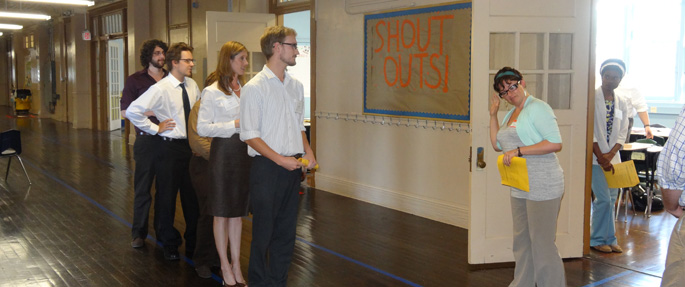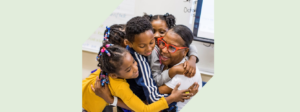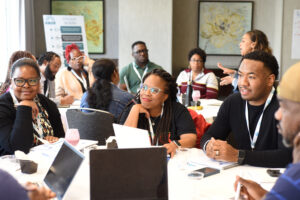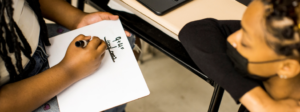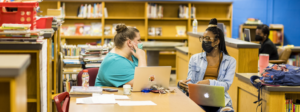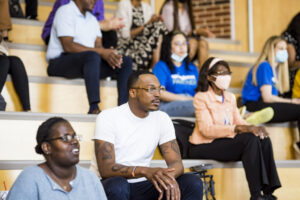About two years ago, I decided to go back to yoga. It had been almost 10 years since my last downward-facing dog when I walked back into my “first” class. I couldn’t touch my toes. But after a lot of hard work and the help of my yoga teachers, now I’m back in the flow.
Re-immersing myself in my yoga practice often reminds me of my work with our Teaching Fellows. As a beginner, I consistently needed my teachers to model a pose or remind me how to stand evenly on both feet in order to keep my balance; even now, I am always grateful when my teacher re-adjusts my pose, pushing my form ever so slightly into a more advanced direction.
My yoga teacher does not expect me to bumble my way toward better practice through trial and error. He knows that the most efficient way to transfer his expertise to me is to show me, and that once I have located my mark once, I’ll have a better understanding of how to do it again. . . on my own. It’s the difference between critique and correction—something our friend Doug Lemov uses as part of his practice-based training approach, which we’ve adopted as part of our partnership (and which Doug recently wrote about).
Our Fellows need the same type of hands-on coaching as they develop into being effective teachers. Without it, they’re bound to keep falling while they try to figure it all out on their own.
I saw this in action last month when I was visiting new Fellows in New Orleans, where our summer coaches were guiding our teachers during their summer training. I was inspired by what I saw, both in terms of how far these new teachers had come after just a few weeks of intense training, and by the immediate and effective feedback I saw coaches provide.
For example, at S.L. Green Charter School, I saw a coach working with a Fellow on how to get students’ attention quickly and deliver instructions on what to do next. It’s the sort of skill that is foundational to strong teaching, but is far from basic—it comprises a few smaller skills that each need to be learned.
At first, the Fellow tried it on her own. It was painful to watch: her attention-getting hand signal was weak and it was impossible to understand or even hear her directions. The coach gave her clear directions: slow down and use a strong voice. The Fellow tried it again. Better. Then, the coach told her how to use firm, authoritative body language, by standing still and “squaring up.” The next round was better still.
They practiced five more times until, on the eighth round, the Fellow executed the skills perfectly. It was amazing: within 15 minutes, she successfully mastered a basic skill that would ground and sustain her teaching practice.
I saw a lot of similarly inspiring coaching, and I attribute the effectiveness I saw to four factors:
- Active coaches. Coaches circulate during lessons and often stop to model a particular skill. They will also intervene with more subtle techniques, like holding up signs to prompt behaviors or using variations on bug-in-ear coaching.
- Direct, specific feedback. Coaches tell Fellows exactly what to do and how to do it, rather than employing an open-ended, exploratory approach. During debriefs, coaches provide bite-sized feedback that focuses on one or two aspects of a Fellow’s performance at a time—just those skills that they believe will immediately make the biggest difference for student learning.
- Immediate practice. Unlike the usual post-observation debrief, where teachers agree to do something “next time,” Fellows practice one-on-one with their coaches right away. Coaches model best practices and have Fellows practice them until they get it—like what I saw at Green.
- Holding Fellows accountable. Coaches observe Fellows’ performance in the classroom to ensure that they are developing at an appropriate pace, especially on targeted skills. That creates an urgency for both coaches and Fellows to reach developmental milestones throughout their training period.
While there’s much to celebrate in the strong coaching I saw in New Orleans, we certainly have not figured it all out. Our coaching model is extremely intense during Fellows’ five-week summer training, and while it continues throughout the school year, it is spread over the course of several months. That raises questions about how frequently we should coach teachers, and how we can maximize the limited capacity we have to do so. We also have found that, so far, our coaches are much more skilled at improving our Fellows’ classroom management skills than increasing their instructional rigor.
As we wrote about in Leap Year, we’ve set a high bar for performance for our Fellows, and teachers who don’t meet it by the end of their first year are not recommended for certification. We owe them the best support we can provide. When the stakes are real and time is short, we think that support is hands-on coaching.
